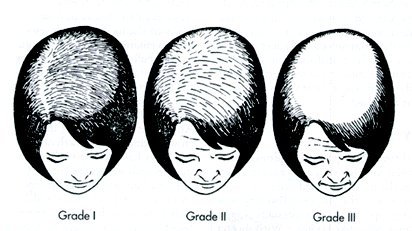Hair Loss in Women Layton, UT
The most common cause of hair loss in women, as it is in men, is androgenic alopecia. The underlying cause is the abnormal effect of androgens (sex hormones like testosterone and testosterone break-down products) on hair follicles. However, the resultant hair loss patterns and the actual effect on the hairs differs among men and women.
female hair loss
 The most widely recognized classification for female pattern hair loss is called the Ludwig’s scale. It is graded on a I-III scale. It should be noted that the pattern differs markedly from that in men. The frontal hair is usually maintained and the entire head tends to diffusely thin, worse on the top. Most will describe a “widening of the part” as the first sign their hair is thinning.
The most widely recognized classification for female pattern hair loss is called the Ludwig’s scale. It is graded on a I-III scale. It should be noted that the pattern differs markedly from that in men. The frontal hair is usually maintained and the entire head tends to diffusely thin, worse on the top. Most will describe a “widening of the part” as the first sign their hair is thinning.
The cause of androgenic alopecia in women, again, is the result of androgenic hormones causing miniturization and shedding of hairs. The role of DHT is less clear. Clearly, there is a genetic predisposition to female-pattern hair loss, but the genes involved are not understood.
While androgenic alopecia is the most common cause of hair loss in women, other medical causes of hair loss are much more common in women than in men. For this reason, all women with significant hair loss should be evaluated by a physician, preferably one who specializes in hair loss conditions. A search for other medical causes of hair loss should be explored. This often requires blood tests and scalp biopsies to ensure that the hair loss is not a manifestation of larger disease process.
This incidence of hair loss in women approaches 20%. There is a bimodal distribution in the age of those effected, first in the late 20’s and the second is in the 50’s. While hair loss in men can be covered with a ball cap and somewhat ignored, hair loss in women can be devastating. Hair loss in women is highly associated with a loss of self-esteem, anxiety and frank depression. Once again, women with significant hair loss should consult with a physician, not just for treatment, but to test for other systemic diseases that may manifest first with hair loss.
Other Diseases Causing Hair Loss
The list below contains the most common causes of hair loss in women besides androgenic alopecia.
Trichotillomania
Psychological condition related to obsessive-compulsive disorder. The hair loss tends to be patchy and a close inspection of the hair will show numerous broken hair fibers of varying lengths. The patient tends to concentrate the hair pulling in one or several areas, causing a patchy appearance. Eyelashes and eyebrows are commonly effected areas. Treatment is mainly focused on treating the psychological disorder and usually includes antidepressant medications. Hair transplants in patients with trichotillomania is strictly contraindicated. A long history of disease “cure” should be seen prior to considering surgical treatment.
Alopecia Areata
Alopecia areata is a disease effecting hair all over the body. It usually presents as round or oval patches of hair loss on the scalp or in the eyebrows. The hair usually grows back within 6 months to one year. Due to the recurrent nature of the disease, most patients will suffer episodes of hair loss in the same areas. In extreme cases, the person can progress to lose all scalp hair (alopecia totalis) and may even lose the eyebrows, lashes and body hair. The cause of alopecia areata is unknown but is considered an autoimmune disease (the body attacks its own hair follicles). Treatment includes steroids (cortisone type medication) either topically or injected. Minoxidil (Rogaine®) can be effective in helping to regrow hair. Surgical treatment of this disorder is generally ineffective and is not recommended.
Traction Alopecia
Traction alopecia is caused by chronic pulling on the hair follicle and is most common in African-American females who use hair styles with tight braids or cornrows. Men who attach hairpieces to their existing hair can also exhibit this type of permanent hairloss when the hairpiece is attached in the same place over a long period of time. Permanent bald patches caused by trichotillomania and traction alopecia are related. In long term cases, both disorders can cause permanent hairloss.
Scarring Alopecia
Hair loss due to scarring of the scalp is called a scarring alopecia. Scarring can be from any number of causes. Injury to the scalp caused by trauma such as burns or avulsions may leave permanent scars and permanent hair loss. Diseases that can cause permanent hair loss due to scalp scarring include: lupus erythematosus and scleroderma, and infection of hair follicles caused by bacteria, fungus, and viral infections such as shingles (herpes zoster).
Triangular Alopecia
The cause of triangular alopecia is unknown, but can often be treated medically or surgically. The characteristic pattern of hair loss in triangular alopecia is thinning or complete loss of hair in the scalp around the temples. If hair loss is incomplete, the remaining hairs are often “miniaturized”-fine-textured hairs of small diameter. Triangular alopecia can begin in childhood with hair loss in the temporal areas of the scalp.
Telogen Effluvium
Telogen effluvium is hair loss caused by a large percentage of scalp hair follicles shifting into the telogen or “shedding phase” of hair growth. The cause of this abnormally timed telogen or resting phase may be hormones, nutritional, drug-related or associated with cases of extreme stress such high fevers, surgeries, accidents and severe illnesses. Time will generally result in a full return of hair growth. Medical and/or surgical treatment is usually not necessary. Chemotherapy agents used in cancer treatment is a recognized cause and excellent example of telogen effluvium.
Loose-Anagen Syndrome
Loose-anagen syndrome occurs mostly in persons who are fair-haired. During the anagen (growth) phase of the hair cycle, scalp hairs sit loosely in the follicles from which they grow and they can be easily removed by combing or brushing. This syndrome can appear in childhood and gradually improve or disappear over time.
It is very important to ensure that the proper cause of hair loss is correctly diagnosed as this may dramatically influence the treatment approach. Often, especially in women, a scalp biopsy should be considered to rule out potentially dangerous causes of hair loss.
Please contact our office by calling (801) 525-8727 or by submitting the online form to request an online consultation.

